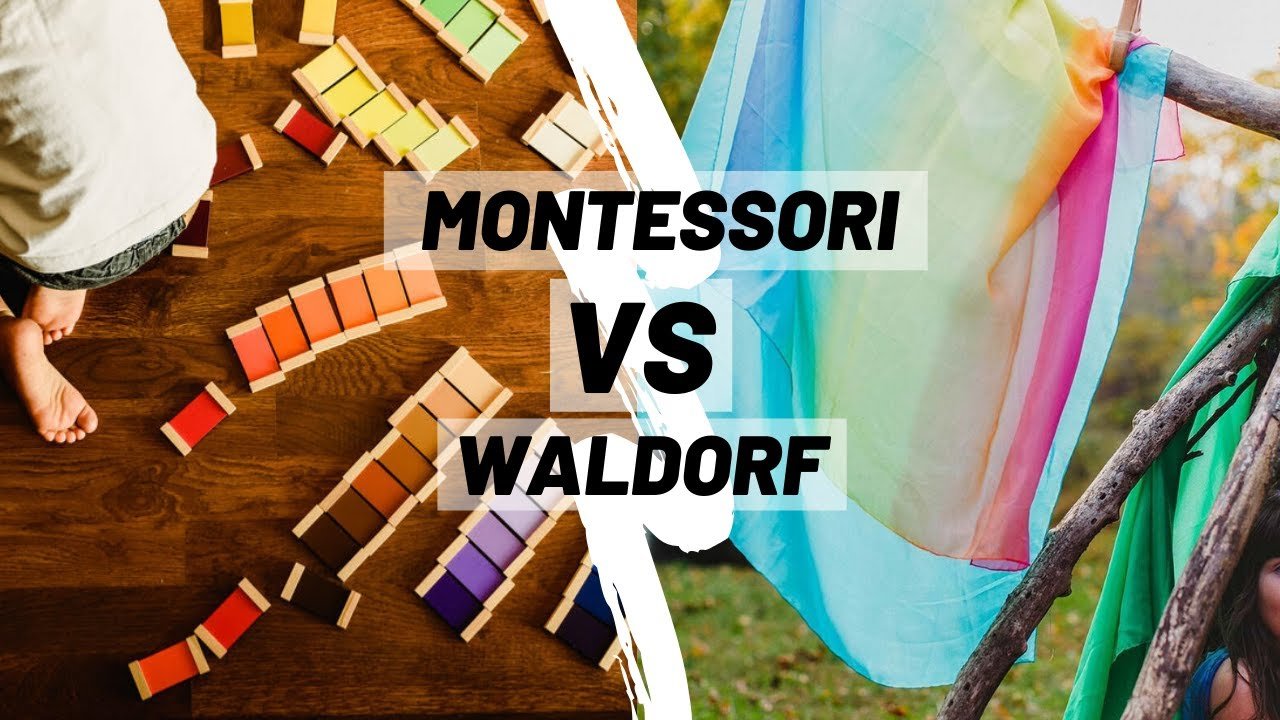You are interested in exploring different educational approaches for young children. One popular comparison is between Montessori and Waldorf approaches, which both emphasize holistic education, character development, and hands-on learning. Montessori focuses on independence, self-sufficiency, and individualized learning through hands-on materials, while Waldorf is child-centered with a focus on imagination, creativity, and natural materials.
Both Montessori and Waldorf approaches share the goal of educating the whole child and fostering a love of learning. Montessori classrooms typically have child-sized furniture and materials organized on accessible shelves, while Waldorf classrooms prioritize play-based learning and teacher guidance. By understanding the similarities and differences between these two approaches, you can make an informed decision about the best educational path for your child.
Overview
When considering alternative educational approaches for young children, Montessori and Waldorf are popular choices that parents often contemplate. While these approaches share some basic ideologies, they differ significantly in their educational philosophies and methodologies. In this article, we will delve into the similarities and differences between Montessori and Waldorf educational approaches to help you make an informed decision for your child’s education.
Brief comparison of Montessori and Waldorf approaches
Montessori and Waldorf are both holistic educational approaches that emphasize character development and practical life skills. They diverge in their teaching styles, use of materials, and overall philosophies. Understanding these distinctions is vital when choosing between the two.
Similarities between Montessori and Waldorf
Both methodologies focus on educating the whole child, using hands-on learning materials, and limiting technology in the classroom. They also prioritize respect for the child and aim to instill a lifelong love of learning.
Differences between Montessori and Waldorf
Montessori centers around independence, self-sufficiency, and individualized learning, while Waldorf emphasizes creativity, imagination, and emotional development. Classroom setups, teaching methods, and overall approaches vary significantly between the two.
Montessori Educational Approach
Montessori education is founded on the principles set forth by Dr. Maria Montessori, focusing on independence, self-directed learning, and respect for the child’s individuality.
Emphasis on independence and self-sufficiency
In a Montessori environment, children are encouraged to choose their own activities, work at their own pace, and develop a sense of responsibility for their learning.
Hands-on materials for academic subjects
Children engage with tactile learning materials designed by Dr. Montessori to promote understanding and mastery of core academic subjects.
Child-sized furniture and organized materials
Classrooms are equipped with child-sized furniture and carefully arranged learning materials displayed on accessible shelves to foster independence.
Use of traditional Montessori materials
Materials like the Pink Tower, Brown Stairs, and Red Rods are staples in Montessori classrooms, offering hands-on learning experiences.
Freedom for children to choose their work
Children have the liberty to select their activities and explore areas of interest, promoting self-motivated learning.
One-on-one or small group lessons
Teachers provide individualized attention through one-on-one or small group lessons, catering to each child’s unique learning style.
Mixed age groupings
Montessori classrooms often feature mixed-age groupings, creating an inclusive and cooperative learning environment.
No homework or testing
The Montessori philosophy eschews traditional homework and testing, focusing instead on experiential learning and practical applications of knowledge.
Waldorf Educational Approach
The Waldorf approach, inspired by Rudolf Steiner’s philosophy, is centered on nurturing imagination, creativity, and a deep connection to the natural world.
Child-centered with teacher as a guide
Teachers in Waldorf classrooms guide children through imaginative play, artistic activities, and hands-on experiences to foster holistic development.
Emphasis on imagination and creativity
Children in Waldorf schools are encouraged to explore their creativity, engage in storytelling, and express themselves through various forms of art.
Play-based and teacher-directed approach
Learning in Waldorf is play-based, with teachers serving as facilitators to create a nurturing and supportive learning environment.
Use of natural materials
Waldorf classrooms are filled with natural materials, organic toys, and items crafted from sustainable resources to foster a connection to the environment.
Children create their own toys and learning materials
Children actively participate in creating their own toys and learning tools, fostering creativity, resourcefulness, and a sense of ownership.
No technology or homework
Waldorf schools limit technology use and avoid homework, focusing instead on hands-on experiences, nature-based activities, and artistic endeavors.

Classroom Environment
Montessori classroom setup
Montessori classrooms feature child-sized furniture, organized learning materials on accessible shelves, and a structured layout that encourages independence and self-directed learning.
Waldorf classroom setup
Waldorf classrooms resemble cozy home environments, decorated with natural materials, gentle pastel colors, and handmade items to create a warm and nurturing atmosphere.
Differences in materials and furniture used
Montessori classrooms incorporate traditional learning materials like wooden puzzles, math manipulatives, and language cards, while Waldorf classrooms emphasize natural, open-ended toys and artistic supplies for creative expression.
Teaching Methods
Approach to teaching core subjects
Montessori emphasizes hands-on learning materials and individualized instruction, while Waldorf focuses on imaginative play, artistic expression, and holistic learning experiences.
Teacher-student interaction
In Montessori, teachers provide one-on-one or small group lessons, promoting personalized instruction and fostering independence. In Waldorf, teachers guide children through play-based activities, storytelling, and artistic endeavors.
Role of technology in education
Both Montessori and Waldorf limit or exclude technology in the classroom, emphasizing real-world experiences, creativity, and hands-on learning.
Homework and testing policies
Montessori classrooms typically have no homework or testing apart from state requirements, while Waldorf schools avoid formal assessments, focusing on experiential learning and character development.
Philosophical Foundation
Overview of Maria Montessori’s philosophy
Dr. Maria Montessori’s philosophy emphasizes independence, respect for the child, and hands-on learning experiences to foster self-directed education and lifelong love of learning.
Overview of Rudolf Steiner’s philosophy
Rudolf Steiner’s philosophy focuses on holistic development, creativity, and connection to nature, guiding children to develop clear thinking, emotional intelligence, and a sense of purpose.
Impact of philosophies on educational approaches
The foundational beliefs of Montessori and Waldorf inform their teaching methodologies, classroom practices, and overall approach to education, shaping the learning experiences of students.
Parental Involvement
Encouragement of parental involvement
Both Montessori and Waldorf schools encourage parental engagement, inviting parents to participate in classroom activities, events, and discussions to support their child’s educational journey.
Supporting the chosen educational approach at home
Parents can reinforce the Montessori or Waldorf philosophy at home by creating a nurturing environment, providing open-ended play materials, and fostering creativity and independence in their children.
Blending Montessori and Waldorf principles at home
Families can combine elements from both Montessori and Waldorf approaches at home, incorporating hands-on activities, nature-based experiences, and artistic expression to create a well-rounded learning environment for their children.
Student Development
Holistic development focus
Both Montessori and Waldorf approaches prioritize holistic development, focusing on intellectual, social, emotional, and physical growth to nurture well-rounded individuals.
Character development strategies
Montessori and Waldorf schools employ character development strategies to instill values, resilience, empathy, and social skills in children, fostering positive relationships and personal growth.
Impact on social and emotional skills
Children in Montessori and Waldorf environments develop strong social and emotional skills through collaborative activities, conflict resolution practices, and opportunities for self-expression, promoting empathy, communication, and self-awareness.
Curriculum
Overview of Montessori curriculum
Montessori curriculum includes practical life activities, sensorial experiences, language development, math concepts, cultural studies, and arts and crafts, tailored to meet the individual needs and interests of each child.
Overview of Waldorf curriculum
Waldorf curriculum integrates storytelling, artistic activities, language arts, mathematics, science, and nature studies, emphasizing creativity, imagination, and a deep connection to the natural world.
Focus areas and subjects covered
Montessori and Waldorf curricula address core academic subjects alongside practical life skills, artistic endeavors, nature exploration, and cultural studies, providing a comprehensive and experiential approach to learning.
Conclusion
When choosing between Montessori and Waldorf educational approaches, it is essential to consider the unique philosophies, methodologies, and classroom environments of each. While Montessori emphasizes independence, self-sufficiency, and hands-on learning, Waldorf focuses on creativity, imagination, and emotional development. Parents should evaluate the key differences between the two approaches, their child’s individual needs and learning style, and their educational goals to make an informed decision. Additionally, blending elements from both Montessori and Waldorf can provide a balanced and enriching educational experience for children, offering opportunities for holistic development, creativity, and lifelong love of learning.

